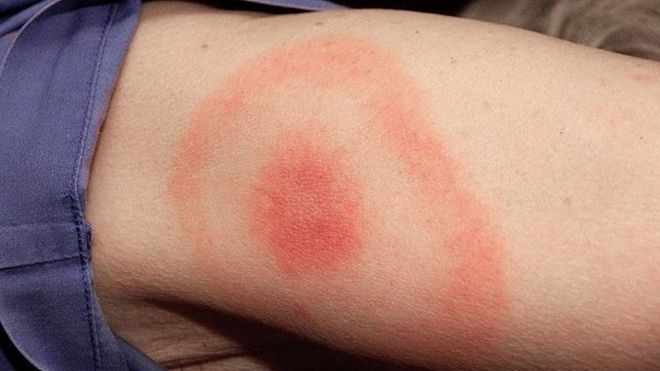Lyme disease can be diagnosed by the rash alone, new advice for the NHS says.

People with the “bull’s eye” circular rash do not need a blood test and should be treated immediately to avoid complications, the National Institute for Health and Care Excellence says.
Waiting for lab results is unnecessary and can cause delays in patients being prescribed the antibiotics they need.
Lyme disease is spread by tick bites and can be debilitating.
A blood tests can check for it but may not give a positive result until eight weeks after the patient is bitten.
Prof Gillian Leng, deputy chief executive and director of health and social care at the National Institute for Health and Care Excellence (NICE), said for most people with Lyme disease, a course of antibiotics would be an effective treatment, “so it is important we diagnose and treat people as soon as possible”.
“A person with Lyme disease may present with a wide range of symptoms, so we have clear advice for professionals about the use of lab tests for diagnosis and the most appropriate antibiotic treatments,” she said.
“If a characteristic bull’s eye rash is present, healthcare professionals should feel confident in diagnosing Lyme disease.”
Lyme disease can be difficult to diagnose. It has similar symptoms to other conditions and there is not always an obvious rash. The rash can also appear in a number of different ways, as these images from the NICE guidance show.
Symptoms can also include:
- a high temperature or feeling hot and shivery
- headaches
- muscle and joint pain
- tiredness
- loss of energy
But if there is a delay in treatment, more severe symptoms can develop months or years later, including:
- pain and swelling in joints
- nerve problems – such as pain or numbness
- heart problems
- loss of memory or concentration
Lyme Disease
Ticks that may cause Lyme disease are found all over the UK
High-risk areas include grassy and wooded areas in southern England and the Scottish Highlands
To reduce the risk of being bitten, cover your skin, tuck your trousers into your socks, use insect repellent and stick to paths
If you are bitten, remove the tick with fine-tipped tweezers or a tick-removal tool found in chemists
Clean the bite with antiseptic or soap and water
The risk of getting ill is low as only a small number of ticks are infected with the bacteria that cause Lyme disease
You don’t need to do anything else unless you become unwell
You should go to your GP if you’ve been bitten by a tick or visited an area in the past month where infected ticks are found and you get flu-like symptoms or a circular red rash
These symptoms can include feeling hot and shivery, headaches, aching muscles or feeling sick